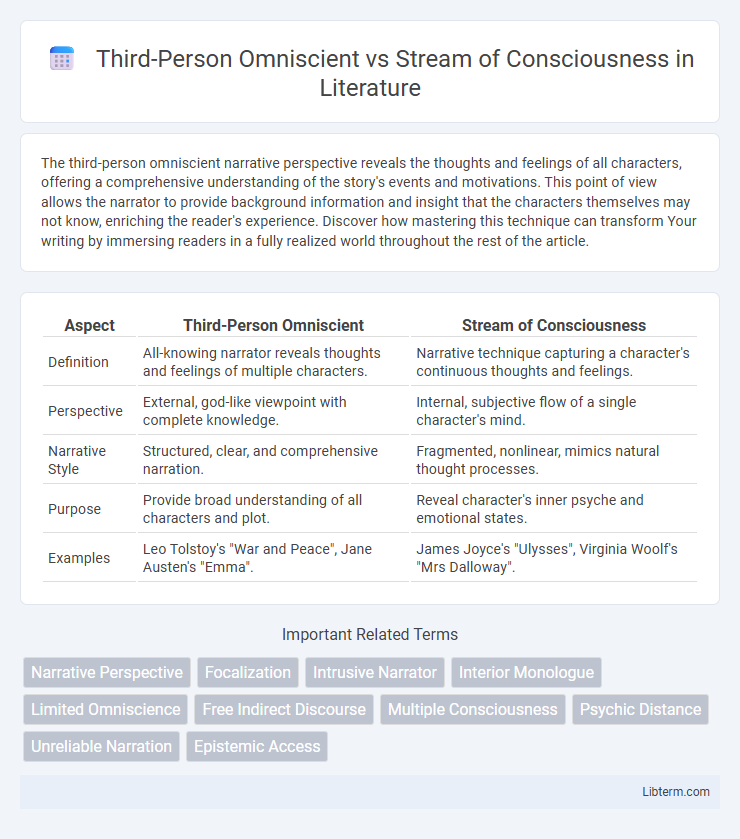The third-person omniscient narrative perspective reveals the thoughts and feelings of all characters, offering a comprehensive understanding of the story's events and motivations. This point of view allows the narrator to provide background information and insight that the characters themselves may not know, enriching the reader's experience. Discover how mastering this technique can transform Your writing by immersing readers in a fully realized world throughout the rest of the article.
Table of Comparison
| Aspect | Third-Person Omniscient | Stream of Consciousness |
|---|---|---|
| Definition | All-knowing narrator reveals thoughts and feelings of multiple characters. | Narrative technique capturing a character's continuous thoughts and feelings. |
| Perspective | External, god-like viewpoint with complete knowledge. | Internal, subjective flow of a single character's mind. |
| Narrative Style | Structured, clear, and comprehensive narration. | Fragmented, nonlinear, mimics natural thought processes. |
| Purpose | Provide broad understanding of all characters and plot. | Reveal character's inner psyche and emotional states. |
| Examples | Leo Tolstoy's "War and Peace", Jane Austen's "Emma". | James Joyce's "Ulysses", Virginia Woolf's "Mrs Dalloway". |
Introduction to Narrative Perspectives
Third-person omniscient narration provides a comprehensive view by revealing the thoughts, actions, and emotions of multiple characters, offering a broad understanding of the story's events. Stream of consciousness, in contrast, delves deeply into the inner experiences of a single character, capturing thoughts in a raw, unfiltered flow. Both narrative perspectives shape readers' engagement, with omniscient narrators enabling an all-encompassing overview and stream of consciousness immersing readers in personal, subjective realities.
Defining Third-Person Omniscient
Third-person omniscient narration offers an all-knowing perspective, revealing the thoughts, feelings, and motivations of multiple characters within a story. This narrative style grants the reader insight into events beyond any single character's knowledge, allowing a comprehensive understanding of the plot and its broader context. Unlike stream of consciousness, which presents the inner monologue of one character, third-person omniscient provides a godlike overview that encompasses diverse viewpoints and information simultaneously.
Understanding Stream of Consciousness
Stream of consciousness is a narrative technique that captures the continuous flow of a character's thoughts, feelings, and sensory experiences in an unstructured or loosely structured manner. This method provides intimate access to the inner workings of a character's mind, often eschewing conventional grammar and linear progression to mirror natural thought patterns. Understanding stream of consciousness enhances comprehension of modernist literature and deep psychological characterization by immersing readers in subjective reality.
Key Features of Third-Person Omniscient
Third-person omniscient narration provides an all-knowing perspective, revealing the thoughts, feelings, and motivations of multiple characters within the narrative. This narrative style utilizes an external voice that can describe events from various locations and times, offering a comprehensive understanding of the story's context. Unlike stream of consciousness, which delves into a single character's inner monologue, third-person omniscient maintains narrative objectivity while presenting a panoramic view of the plot and character dynamics.
Core Characteristics of Stream of Consciousness
Stream of consciousness is a narrative technique characterized by an unfiltered, continuous flow of a character's thoughts, feelings, and sensory experiences, often presented in a nonlinear and fragmented manner. Unlike third-person omniscient, which provides an all-knowing narrator with access to multiple characters' perspectives, stream of consciousness delves deeply into a single character's internal mindscape. This method emphasizes subjective reality and mimics natural thought processes, capturing the complexity and spontaneity of human cognition.
Advantages of Third-Person Omniscient Narration
Third-person omniscient narration offers a comprehensive perspective by revealing the thoughts, feelings, and motivations of multiple characters, enriching the story's depth and complexity. This narrative style enables seamless shifts between scenes and characters, providing a broader understanding of the plot and contributing to more dynamic storytelling. By supplying objective insights and contextual information, third-person omniscient narration enhances the reader's engagement and delivers a well-rounded, immersive experience.
Strengths of Stream of Consciousness Technique
The stream of consciousness technique excels in providing direct access to a character's inner thoughts and emotions, creating an intimate and immersive experience for readers. This narrative style captures the fluid, often fragmented nature of human cognition, allowing for a deep psychological exploration that third-person omniscient narration cannot replicate. By presenting thoughts as they naturally occur, stream of consciousness reveals complex character motivations and subjective realities with unmatched authenticity.
Common Uses in Literature
Third-person omniscient narration is commonly used in epic novels and classic literature to provide a comprehensive view of multiple characters' thoughts, backgrounds, and motivations, enriching plot complexity and thematic depth. Stream of consciousness is frequently employed in modernist literature and psychological narratives to immerse readers in a character's internal experience, capturing spontaneous thoughts and emotions in a fragmented, non-linear flow. Both techniques serve distinct narrative purposes: third-person omniscient enhances external world-building and multiple perspectives, while stream of consciousness offers intimate access to a single mind's subjective reality.
Notable Examples in Classic and Modern Works
Notable examples of third-person omniscient narration include Leo Tolstoy's "War and Peace" and George Eliot's "Middlemarch," where the narrator provides an all-encompassing perspective on multiple characters and events. Stream of consciousness is exemplified in James Joyce's "Ulysses" and Virginia Woolf's "Mrs. Dalloway," capturing the inner thoughts and feelings of characters in a continuous flow. Modern works like Haruki Murakami's novels blend these techniques, offering both expansive narration and intimate psychological depth.
Choosing the Right Narrative Style
Choosing the right narrative style depends on the story's scope and character insight needs. Third-person omniscient offers a god-like perspective, revealing multiple characters' thoughts and broader context, ideal for complex plots. Stream of consciousness delves deeply into a single character's internal experience, capturing raw, fragmented thoughts for an immersive, intimate narrative.
Third-Person Omniscient Infographic

 libterm.com
libterm.com